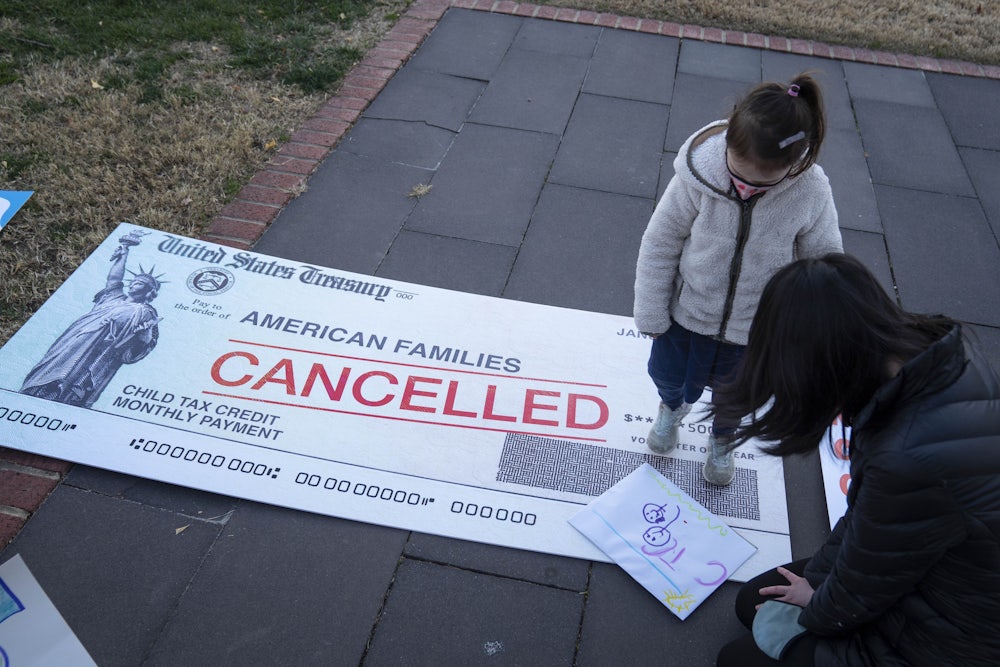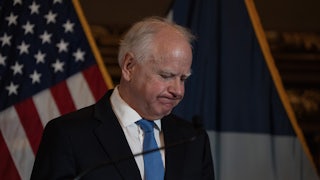Multiple state governments have recently considered or enacted their own child tax credit, nearly two years after a dramatic expansion of the federal child tax credit expired. But while the effort to implement and reinstate the expanded federal credit was spearheaded by congressional Democrats and the Biden administratration, statewide efforts have been far more bipartisan, with red states just as likely as blue ones to enact their own child tax credits.
The 2021 expansion of the federal child tax credit lifted millions of children out of poverty in the six months it was in effect, making it one of the most effective anti-poverty measures in recent memory. That expansion, authorized by the massive coronavirus relief legislation that passed shortly after President Joe Biden took office, expired at the beginning of 2022. Despite efforts from its supporters in Congress, opposition from all congressional Republicans and at least one Democrat blocked its reinstatement on a federal level.
Aidan Davis, state policy director at the left-leaning Institute on Taxation and Economic Policy, or ITEP, told me that the temporary federal expansion “put child tax credits on the map as a really meaningful policy.” “I think the states are just really stepping up and following suit, and filling the gap with uncertainty of what’s going to happen at the federal level,” Davis said.
Since 2019, 14 states have introduced legislation to enact state child tax credits, according to the National Conference of State Legislatures. After the expiration of the expanded federal child tax credit in 2022, three states—New Mexico, New Jersey, and Vermont—created new child tax credits to fill the vacuum. But not all state child tax credits are created equal, or even alike. The amount of the credit differs across states, as do income requirements and the age limit for children to receive the credit.
As of the end of 2022, 10 states had implemented child tax credits, according to a count by ITEP, although the eligibility requirements vary. The credit is refundable in nine of these states, meaning that the credit is accessible to households that are too poor to pay income taxes—one of the defining features of the federal expansion. Other states, including Connecticut and Rhode Island, had temporary, limited policies in 2022. Maryland this week also expanded its initially temporary credit to become permanent, but it remains small compared to measures in other states.
“There’s a bunch of pieces of [a child tax credit policy] that are super important to get right, and I think a lot of the states are getting pieces of it right, and it’s just a matter of making sure you get as many of the pieces right as possible,” Davis said. She highlighted refundability as one of those most crucial elements, as well as providing the credit to children up to age 18 and for immigrant families. A November analysis by ITEP found that states could cut child poverty by a quarter or in half by implementing a child tax credit that includes these specific provisions from the expanded federal credit: refundability, larger proceeds for children under age 6, and monthly disbursements instead of an annual lump sum.
Josh McCabe, the director of social policy at the Niskanen Center, highlighted Massachusetts’ child tax credit proposal as a particularly effective example. “What they did was take an exemption and convert it into a credit, and keep it universal. So that just makes it easier to administer, it just helps to keep the cost down and build a better foundation to expand it in the future,” said McCabe, who has written extensively on state child tax credit proposals. A child tax credit was initially proposed by former Governor Charlie Baker, a Republican, but was ultimately not enacted. Current Governor Maura Healey, a Democrat, has proposed a similar and even larger credit for children under 13, as part of a tax relief package that was approved in the state House last week.
Meanwhile, other states like Maine, Minnesota, Nebraska, New York, and Utah are currently considering enacting or expanding their child credit policies. (Maine currently has a credit that is nonrefundable; the new proposal would make the credit refundable and increase the amount.)
Given that the idea of a child tax credit was so polarizing on the federal level, it may seem inconsistent that such policies garner the support of Republican governors as well as Democratic ones. The expanded credit implemented by the American Rescue Plan was seen by Republicans as a Biden administration policy, while Democrats opposed President Donald Trump’s massive tax cut package in 2017 even as it included an expansion of the federal child tax credit from $1,000 to $2,000 annually.
But on the state level, McCabe said, child tax credits were implemented more “quietly.” He highlighted the policies proposed in northeastern states with moderate Republican governors, such as Massachusetts and Vermont. “You have those traditional, New England Republicans who like the simplicity and don’t have as much polarization,” McCabe said.
It isn’t just moderate Republicans who support child tax credits. In Utah, Republican Governor Spencer Cox recently signed a massive tax cut package that included a child tax credit for children ages 1 through 3 in low- and moderate-income households. (However, the credit is nonrefundable, benefiting only around 21,000 Utah households.)
Montana Governor Greg Gianforte, a more populist Republican than his northeastern counterparts, has also pressed for a child tax credit. “We definitely see this child tax credit as being a pro-family and pro-child tax policy that encourages self-sufficiency and supports families,” said Caitlin Jensen, the executive director of Zero to Five Montana, a statewide advocacy organization focused on early childhood education and care.
But as I previously reported, Gianforte’s proposal, a relatively generous $1,200-per-child tax credit for children under 6 years old in households earning less than $50,000, was stymied in the state legislature by Democrats. Gianforte has said he will continue to advocate for the measure.
In a post-Roe era, some Republicans see child tax credits as a way to promote the creation and stability of families. “Family is the foundation of our society. We should do everything we can to make families stronger,” Gianforte said in January.
Public opinion may also be a contributing factor in the bipartisan willingness to tackle statewide child tax credits. An October poll by Lake Research Partners, a Democratic polling firm, found that 75 percent of voters nationwide supported the child tax credit. According to a November poll by Morning Consult, 85 percent of parents of children aged 3 and under believe it is very or somewhat important for Congress to reinstate the expanded federal child tax credit.
Experts say that a state child tax credit could be complemented by a federal one. McCabe pointed to Canada, which has a federal-level child benefit along with provincial benefits; many provinces combine their benefit with the federal benefit for a single monthly payment. The U.S. is far from adopting such a system: As Republicans now control the House, congressional action on the issue seems ever more unlikely. However, Davis expressed hope that the momentum around statewide policies could lead to further discussions about the efficacy of child tax credits.
“Given that that federal expansion has not yet been made permanent, I think it’s more imperative than ever that state lawmakers pursue new or expanded refundable child tax credits in their states,” said Davis. “So while we may see a missed opportunity at the national level, this does not impact states’ ability to enact meaningful refundable credits.”










